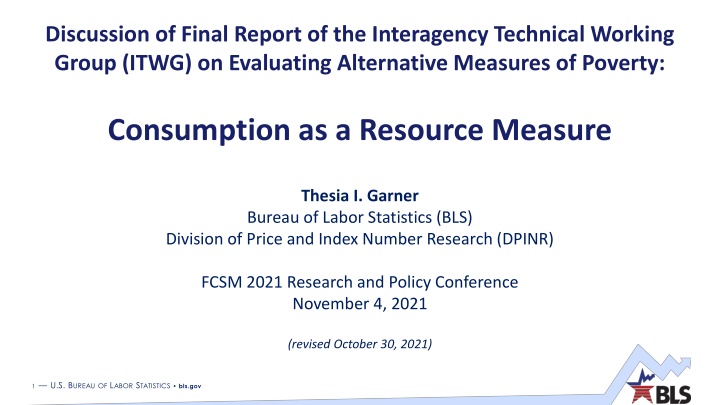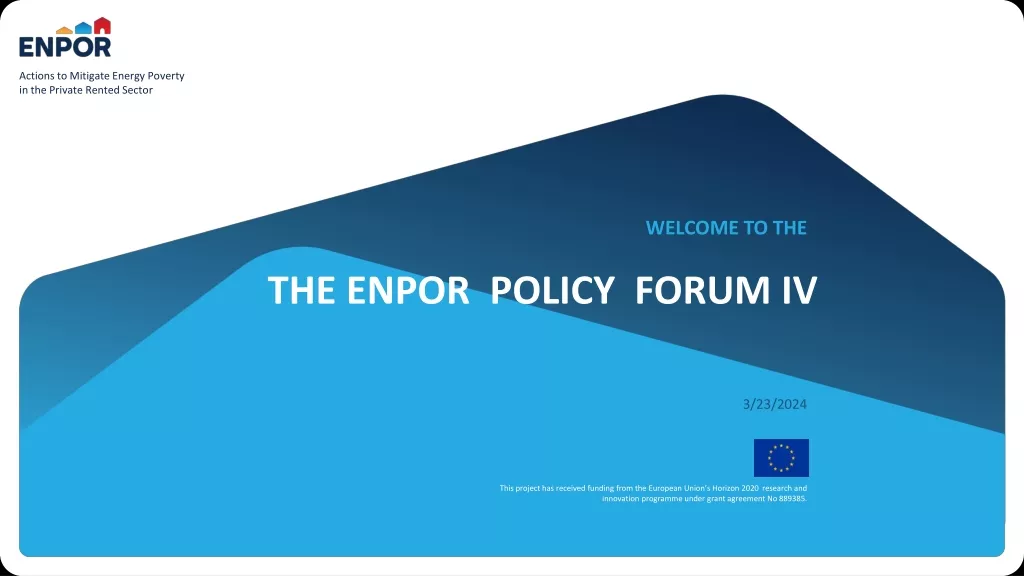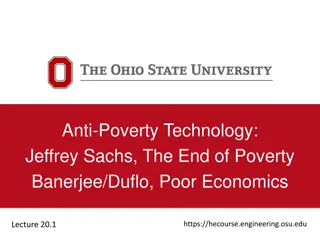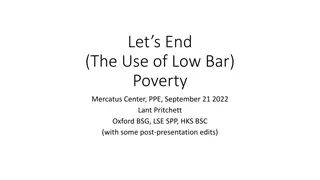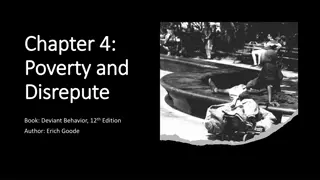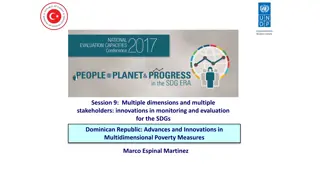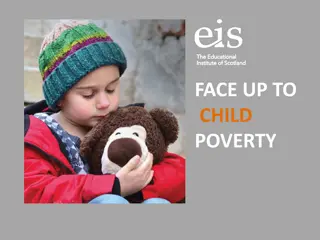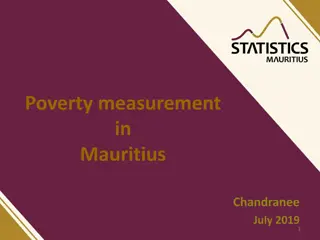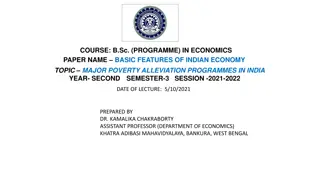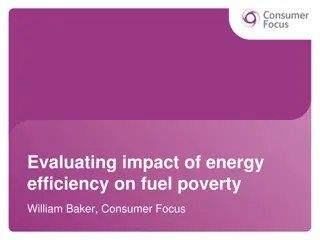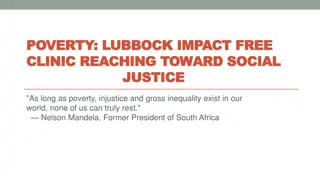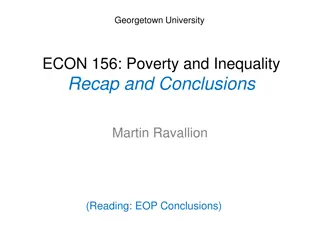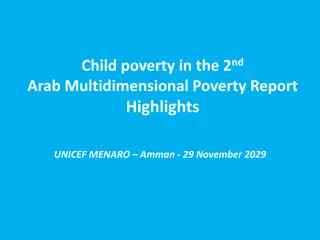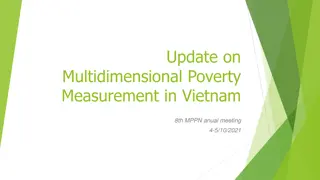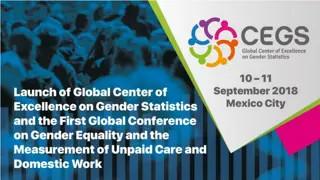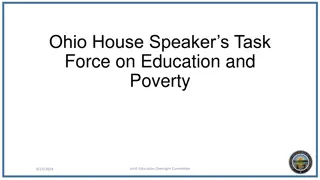Evaluating Consumption-Based Measures of Poverty
Discussion of the Final Report by the Interagency Technical Working Group on the use of consumption as a resource measure. Insights on why consumption-based measures are valuable, what to include, challenges, data quality, and implementation recommendations.
Download Presentation

Please find below an Image/Link to download the presentation.
The content on the website is provided AS IS for your information and personal use only. It may not be sold, licensed, or shared on other websites without obtaining consent from the author.If you encounter any issues during the download, it is possible that the publisher has removed the file from their server.
You are allowed to download the files provided on this website for personal or commercial use, subject to the condition that they are used lawfully. All files are the property of their respective owners.
The content on the website is provided AS IS for your information and personal use only. It may not be sold, licensed, or shared on other websites without obtaining consent from the author.
E N D
Presentation Transcript
Discussion of Final Report of the Interagency Technical Working Group (ITWG) on Evaluating Alternative Measures of Poverty: Consumption as a Resource Measure Thesia I. Garner Bureau of Labor Statistics (BLS) Division of Price and Index Number Research (DPINR) FCSM 2021 Research and Policy Conference November 4, 2021 (revised October 30, 2021) 1 U.S. BUREAU OF LABOR STATISTICS bls.gov
Outline Why a consumption-based measure of resources? What to include? How to define? Recommendations and comments Select challenging components (i.e., education, health, non-financial assets) Data quality including administrative data Data source Funding Implementation and future direction 2 U.S. BUREAUOF LABOR STATISTICS bls.gov
Why a Consumption-Based Measure of Resources? Focus on not how we could live, but how we do live Consumption-based measure may more directly capture the resources available to a family if it records the consumption that was actually achieved Conceptually, such a measure reflects long-run resources and one s ability to smooth consumption over life cycle Depends on Current income; public and private transfers/in-kind benefits; assets (financial and non-financial); access to credit Stage in one s life-cycle, changes in family composition Expectations/uncertainty about future income, employment, inflation, bequest motives, preferences Time Examples of pros and cons Good measure to identify who is poor based on material deprivation Empirical studies suggest that people may report more accurately expenditures (a component of consumption) than income May not be a good if interested in short-term impacts of temporary fluctuations income 3 U.S. BUREAUOF LABOR STATISTICS bls.gov
Life Cycle Theory of Consumption suggests that individuals plan their consumption and savings behavior over the course of their lives from assets including pensions Loans Transfers from family Retirement years Working years Youth years 4 U.S. BUREAUOF LABOR STATISTICS bls.gov Image address: https://www.oecd-ilibrary.org/sites/9789264281288-12-en/images/images/graphics/g9-1.png
ConsumptionWhat to Include? How to Define? Expenditures In-kind benefits Exclude expenditures Allocations to pensions and life insurance are assumed to enhance future consumption Owned shelter and vehicle purchases To include or exclude? Health expenses Education expenditures Flow of services 5 U.S. BUREAUOF LABOR STATISTICS bls.gov
Consumption: Service Flows from Non-financial Assets Why account for service flows? Because we do not consume the house or car, instead we consume the flows of services (market or consumption value) from these Primarily two main valuation approaches used internationally User costs Rental equivalence Both to measure change over time in the value for the flow of services consumed by owner-occupants or vehicle owners In theory, both approaches should produce equivalent values, but rarely do empirically Literature Focuses on owner-occupied housing Implication that the same or similar methods can be used for durables or non-financial assets like vehicles (see ILO 2003, paragraph 292) 6 U.S. BUREAUOF LABOR STATISTICS bls.gov
Consumption: Service Flows Defined in Terms of User Costs Costs of producing (using) the service: user cost approach attempts to measure the changes in the cost to owner-occupiers of using the dwelling; user costs account for both recurring costs and the opportunity cost of having money tied up in the dwelling rather than being used for some other purpose (ILO 2004, p. 179). Components of user costs Recurring costs like mortgage interest payments, property taxes, property insurance, and routine maintenance and repairs (including those for major appliances included in the shelter unit when covered by the rental contract) Opportunity costs of investing in this shelter property as opposed to another asset or for another purpose Depreciation rate Expected appreciation rate Income tax rate (advantages of owning: lowers user costs) 7 U.S. BUREAUOF LABOR STATISTICS bls.gov
Consumption: Service Flows Defined in Terms of Rental Equivalence Selling price of the service: rental equivalence approach attempts to measure the change in the price of the housing service consumed by owner-occupants by estimating the market value of those services (ILO 2004, p. 180) Market rent that landlord would charge for a unit (selling price of the service provided by the housing structure) The rent an owner occupant would pay to rent her own home In the U.S., service flows from major appliances (e.g., refrigerators, stoves) are included in comparable rental units, unlike in many European countries, and thus are implicitly included in rental equivalence Most often used valuation approaches Imputed rents (e.g., from regression models) + premium Reported rental equivalence (asked in CE Interview) 8 U.S. BUREAUOF LABOR STATISTICS bls.gov
Rental Equivalence and Adjustments for Renter-like Expenditures Rental equivalence question in CE Interview If someone were to rent this dwelling how much do you think it would rent for monthly, unfurnished and without utilities? Optional treatments for owner shelter-related expenses (those not implicitly included in rental equivalence) 1. Exclude all 2. Ratio adjust as is done for Consumer Price Index to make them renter-like , for example Adjust expenditure for homeowners insurance premium by a factor is 0.41 to reflect the share that only covers contents and personal items (tenants insurance) Adjust expenditures for homeowners landscape maintenance by a factor of 0.061 to reflect share not covered by rental equivalence (rental contracts that require renter to maintains the yard at their own expense) 9 U.S. BUREAUOF LABOR STATISTICS bls.gov
Recommendations 10 U.S. BUREAUOF LABOR STATISTICS bls.gov
Accounting for Health in Consumption Recommendations #5, 13, 14, 15, 16 Recommendation 5. The Working Group recommends that the Bureau of Labor Statistics develop and publish two new sets of research measures of consumption-based resources 1. Includes a value of health insurance (e.g., market value, willingness to pay, fungible value) 2. Does not include a value of health insurance Treatment of non-premium medical out-of- pocket expenditures not covered by insurance, e.g., co- pays, deductibles, prescription drugs, and over the counter items requires further research Current status No plans in response to ITWG Report Related: BLS research initiative to develop a consumption measure of economic well-being, and measure of consumption expenditures for distributional accounts (CE-PCE project) 11 U.S. BUREAUOF LABOR STATISTICS bls.gov
Recommendations #17, 19: Education 17. The Working Group recommends that expenditures on education be excluded from the recommended extended income-based and consumption-based resource measures because education is generally considered an investment in human capital. 19. The Working Group recommends continued research and additional stakeholder and expert engagement on whether and how to treat education within resource measures. Current status No plans in response to ITWG Report 12 U.S. BUREAUOF LABOR STATISTICS bls.gov
Recommendation # 27: Service Flows from Non-financial Assets 27. The Working Group recommends that the value of service flows from owner-occupied shelter and the value of the service flows from owned vehicles be included in the consumption resource measures. Current status CE Interview already includes rental equivalence for owner-occupied housing Related: BLS research to produce flow of services cars and trucks 13 U.S. BUREAUOF LABOR STATISTICS bls.gov
Recommendations #6, 23: Administrative Data 6. The Working Group recommends that the Census Bureau and the Bureau of Labor Statistics use, where available and when appropriate, administrative data to supplement or replace the use of survey data for developing the recommended measures. 23. The Working Group recommends that the advisory structure recommended previously should vet decisions about data sources, adjustment strategies, and other assumptions. This advisory structure should consider and discuss continued research into availability and applicability of administrative data sources. Current status No plans in response to ITWG Report Related: regular CE work to improve data quality Proof of concept project: match of CE Interview and HUD administrative data for 2013 to 2017 for voucher recipients and consumer units living in public housing (under revision) 14 U.S. BUREAUOF LABOR STATISTICS bls.gov
Recommendation #22 (in part): Model-Based Approaches Regression-based modeling (with or without individual-level or aggregate administrative data) can also improve the quality of estimates of income, expenditures, and program participation Current status No plans in response to ITWG Report Related: research for Supplemental Poverty Measure (SPM) thresholds could be adapted for production of consumption-based resource Imputation of non-collected in-kind benefits in the CE for NSLP, WIC, home energy assistance using CPS ASEC in combination with CE, and NSLP and WIC benefits data from USDA Imputation of market rents, using CE Interview data for renters paying market rents and renters living in public housing, rent-controlled units, receiving financial assistance with rent (e.g., voucher), rent as pay 15 U.S. BUREAUOF LABOR STATISTICS bls.gov
Recommendation #24: Data Quality 24. The Working Group recommends that the Census Bureau and the Bureau of Labor Statistics continue to research, and possibly implement, ways to reduce survey burden and improve the quality of resulting data through increased access and use of administrative data in surveys, including the CE. Current status No plans in response to ITWG Report Related: regular CE work to improve data quality Developing streamlined Interview questionnaire (some on progress, others first phase April 2023) Reduce the level of detail started April 2021 (e.g., for apparel, can no longer distinguish between men and women, or boys and girls, or infants; only by age group: 18 years and older; 0-17 years of age) Facilitate the use of records Some changes to the order and section organization Developing Consumer Assisted Recorded Interview (CARI) for Interview to be implement in July 2022; goal to improve data collection and question wording 16 U.S. BUREAUOF LABOR STATISTICS bls.gov
Recommendation # 26: Data Source 26. The Working Group recommends that the Bureau of Labor Statistics use the CE Interview Survey data to research and develop a consumption-based resource measure. Current status Response to ITWG Recommendation #26: planned presentation on consumption resource poverty during ASSA/AEA Annual Meetings 2022 Related: BLS research initiative to develop a consumption measure of economic well-being 17 U.S. BUREAUOF LABOR STATISTICS bls.gov
Recommendations # 28, 29: Geographic Area for Estimates 28. The Working Group recommends that the CE Interview serve as the primary data source for the production of the consumption resource measures, with estimates produced at the state level. 29. The Working Group recommends that the current CE Interview Survey serve as the interim data source for the production of the consumption resource measures, with estimates produced at the Census Division level. Current status No plans in response to ITWG Recommendations 18 U.S. BUREAUOF LABOR STATISTICS bls.gov
Recommendation # 25: Funding 25. The Working Group recommends funding support of the work to develop the new recommended measures, including funding to support BLS to research the nature and construction of a potential consumption-based poverty measure and improve the CE program in support of improved poverty measurement. A proposal requesting $7.1 million was included in the fiscal year 2021 President s Budget. $7.1 million included in President s FY2021 Budget request to Congress for BLS Conduct research on potential consumption-based poverty measure Improvement in CE program in support of production-quality SPM thresholds Funds not included in the final FY2021 appropriation from Congress Current status No additional plans in response to ITWG Report (request made in 2020 during ITWG meetings) Continues to be much interest within BLS supporting this work Related: BLS research initiative to develop a consumption measure of economic well-being 19 U.S. BUREAUOF LABOR STATISTICS bls.gov
Recommendation #1: Engage with Stakeholders The Working Group recommends that the Census Bureau and the Bureau of Labor Statistics engage with stakeholders and other experts throughout the development of the recommended measures Current status No plans in response to ITWG Report Related BLS research initiative to develop a consumption measure of economic well-being Consumption Symposium, virtual in September 22-23, 2021 (see https://stats.bls.gov/cex/consump_symposium.htm ) Federal Statistics Advisory Committee (FESAC) meeting, December 10, 2021 Research presentation during ASSA/AEA 2022 20 U.S. BUREAUOF LABOR STATISTICS bls.gov
Challenges for a Consumption Resource Measure: Implementation Issues and Future Direction Implementation Consumer Expenditure Survey Interview, Diary, both Sample size, geography No to little data collected on in-kind transfers (public, private) Misreporting and under-estimates Redesign efforts could complicate production of a consistent measure of consumption over time Administrative data (e.g., public in-kind benefits) Availability, coverage, quality, timeliness Permission to use Alignment with survey concepts Disagreement between administrative and survey sources Imputation methods Future Direction: integrate ITWG Recommendations with BLS initiative to produce a consumption measure of economic well-being 21 U.S. BUREAUOF LABOR STATISTICS bls.gov
Contact Thesia I. Garner, Ph.D. Chief, Division of Price and Index Number Research Office of Prices and Living Condition Bureau of Labor Statistics Washington, DC 20212 Garner.Thesia@BLS.gov Office telephone: (202) 691 6576 22 U.S. BUREAUOF LABOR STATISTICS bls.gov
Current CE Design - 2 one-week household paper* diaries - Contemporaneous recall - Small, frequently purchased items - 4 waves of personal interviews - 3-month recall - Large or recurring expenditures Consumer Expenditure Survey Estimates 23 U.S. BUREAUOF LABOR STATISTICS bls.gov Slide from presentation by Laura Erhard, CE Division, Survey Methods Symposium, July 20, 2021
CE Design CE Diary and Interview CE Interview Current design: 4 interviews, 3- month reference period No requirement that consumer units remain in 4 quarters (quarterly data assumed independent; no longitudinal weights) Consumer units (CUs) enter the sample on a rolling, not calendar-year, basis (data collection period, for example, first interview in June 2020 reference period of March, April, and May 2020; and last interview in February 2021 with reference period of December 2020 through February 2021) Relevant data for consumption measure: expenditures, rental equivalence of owned home, stock of owned vehicles, presence of health insurance (private-self, employer-provided, Medicaid, Medicare, other government), CU demographic variables 24 U.S. BUREAUOF LABOR STATISTICS bls.gov
Gemini Redesign Plan You are here! 2023 onwards: 2022: Phased Implementation of Streamlined Questionnaire 2020: Large Scale Feasibility Online Diary Test (LSF) complete Online Diary Implementation 2016: Incentives Test complete 2015: Proof of Concept Test complete 2013: Redesign Plan approved 25 U.S. BUREAUOF LABOR STATISTICS bls.gov Slide from presentation by Laura Erhard, CE Division, Survey Methods Symposium, July 20, 2021
BLS Production of a Consumption Measure Who? Researchers and staff in Divisions of Price and Index Number Research (DPINR) and Consumer Expenditure Surveys (DCES) with assistance from OEUS and outside research community Support from Commissioner Beach (April 2021) What? OECD 2013 Framework definition Consumption expenditure - value of consumption goods and services used or paid for by a household to directly meet its needs purchase of goods and services in the market consumption flows from owner-occupied housing, vehicles, and durables in-kind transfers from employers barter of goods and services household s own production of goods and services consumed transfers in-kind from other households (e.g., gifts) and from businesses GOAL: Actual final consumption - sum of consumption expenditure value of social transfers in kind provided by government and non-profit institutions 26 U.S. BUREAUOF LABOR STATISTICS bls.gov Source: OECD (2013), OECD Framework for Statistics on the Distribution of Household Income, Consumption and Wealth, OECD Publishing, Paris, Chapter 5. Household Consumption, p.104.
Activities at BLS: Consumption Symposium and Beyond Consumption Symposium Topics Theory, concepts Non-traditional views/measures of consumption (e.g., time in consumption, within household sharing/allocation, as part of multidimensional measures) In-kind benefits and use of administrative data Durables Health insurance Home production Next steps Internal/external document (past, present, future) Building on earlier CE framework (2000) Follow international standards/guidelines Moving from CE publication definition of expenditures to consumption measure of economic well-being Developing measures for uses (e.g., CE to PCE distributional accounts, poverty measurement) 27 U.S. BUREAUOF LABOR STATISTICS bls.gov
